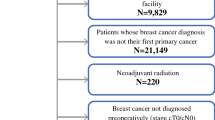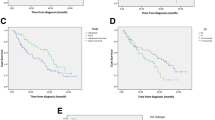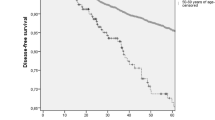Abstract
Breast cancer (BC) is the most common cancer worldwide among women. In Japan, the incidence of BC gradually increased. The recent number of adolescent and young adult (AYA)-BC patients is approximately 4,000–5,000 every year, accounting for 5% of all BC cases. BC in young people has been attracting attention since Japan's third basic plan to promote cancer control programs incorporated cancer control measures for pediatric (age ≤ 14 years) and adolescent and young adult (AYA)-generation (age 15–39 years) cancers in 2018. Attention is needed to detect AYA-BC because of the presence of dense breasts. AYA-BC patients are clinically characterized by larger tumor size, more lymph node metastases, advanced stages, and a higher rate of aggressive phenotypes, such as triple-negative or HER2-positive subtypes, and are strongly associated with family history and genetic germline alterations, including hereditary breast and ovarian cancers. Given that AYA-BC patients show a poorer prognosis than older BC patients, they often require intensive therapies, including surgery, radiation, chemotherapy, and endocrine therapy. We must solve many survivorship-associated problems in AYA-BC patients, including fertility preservation, comorbidity after treatment, and long-term follow-up. Under these circumstances, national and local governments and various academic societies have started addressing these problems by formulating laws and guidelines, establishing medical systems, and offering financial support to conquer cancer and maintain a better quality of life. This review summarizes the current trends of AYA-BC worldwide and in Japan. Further Japan-specific data on AYA-BC are required to clarify its characteristics and improve prognosis and survivorship.



Similar content being viewed by others
References
Siegel RL, Miller KD, Fuchs HE et al (2021) Cancer statistics, 2021. CA Cancer J Clin 71:7–33
National Cancer Center (2021) Center for cancer control and information services. https://ganjoho.jp/public/index.html. Accessed Sept 2021
Ministry of Health, Labour and Welfare (2018) The third basic plan to promote cancer control programs. https://www.mhlw.go.jp/stf/seisakunitsuite/bunya/0000183313.html. Accessed Sept 2021
Inoue I, Nakamura F, Matsumoto K et al (2017) Cancer in adolescents and young adults: national incidence and characteristics in Japan. Cancer Epidemiol 51:74–80
Gupta S, Harper A, Ruan Y et al (2020) International trends in the incidence of cancer among adolescents and young adults. J Natl Cancer Inst 112:1105–1117
Bleyer A, Barr R, Hayes-Lattin B et al (2008) The distinctive biology of cancer in adolescents and young adults. Nat Rev Cancer 8:288–298
Anders CK, Johnson R, Litton J et al (2009) Breast cancer before age 40 years. Semn Oncol 36:237–249
Gewefel H, Salhia B (2014) Breast cancer in adolescent and young adult women. Clin Breast Cancer 14:390–395
Hayashi N, Kumamaru H, Isozumi U et al (2020) Annual report of the Japanese breast cancer registry for 2017. Breast Cancer 27:803–809
Copson E, Eccles B, Maishman T et al (2013) Prospective observational study of breast cancer treatment outcomes for UK women aged 18–40 years at diagnosis: the POSH study. J Natl Cancer Inst 105:978–988
Keegan TH, DeRouen MC, Press DJ et al (2012) Occurrence of breast cancer subtypes in adolescent and young adult women. Breast Cancer Res 14:R55
Kataoka A, Iwamoto T, Tokunaga E et al (2016) Young adult breast cancer patients have a poor prognosis independent of prognostic clinicopathological factors: a study from the Japanese Breast Cancer Registry. Breast Cancer Res Treat 160:163–172
Kataoka A, Tokunaga E, Masuda N et al (2014) Clinicopathological features of young patients (<35 years of age) with breast cancer in a Japanese Breast Cancer Society supported study. Breast Cancer 21:643–650
Hironaka-Mitsuhashi A, Tsuda H, Yoshida M et al (2019) Invasive breast cancers in adolescent and young adult women show more aggressive immunohistochemical and clinical features than those in women aged 40–44 years. Breast Cancer 26:386–396
Pharoah PD, Day NE, Duffy S et al (1997) Family history and the risk of breast cancer: a systematic review and meta-analysis. Int J Cancer 71(5):800–809
Collaborative group on hormonal factors in breast cancer (2001) Familial breast cancer: collaborative reanalysis of individual data from 52 epidemiological studies including 58,209 women with breast cancer and 101,986 women without the disease. Lancet 358:1389–1399
Antoniou A, Pharoah PD, Narod S et al (2003) Average risks of breast and ovarian cancer associated with BRCA1 or BRCA2 mutations detected in case series unselected for family history: a combined analysis of 22 studies. Am J Hum Genet 72:1117–1130
Dorling L, Carvalho S, Allen J et al (2021) Breast cancer risk genes—association analysis in more than 113,000 women. New Engl J Med 384:428–439
Hu C, Hart SN, Gnanaolivu R et al (2021) A population-based study of genes previously implicated in breast cancer. New Engl J Med 384:440–451
Reiner AS, Sisti J, John EM et al (2018) Breast cancer family history and contralateral breast cancer risk in young women: an update from the women’s environmental cancer and radiation epidemiology study. J Clin Oncol 36:1513–1520
Johnson RH, Hu P, Fan C et al (2015) Gene expression in “young adult type” breast cancer: a retrospective analysis. Oncotarget 6:13688–13702
Ogawa H, Kato I, Tominaga S (1985) Family history of cancer among cancer patients. Jpn J Cancer Res 76:113–118
Kaneyasu T, Mori S, Yamauchi H et al (2020) Prevalence of disease-causing genes in Japanese patients with BRCA1/2-wildtype hereditary breast and ovarian cancer syndrome. NPJ Breast Cancer 6:25
Momozawa Y, Iwasaki Y, Parsons MT et al (2018) Germline pathogenic variants of 11 breast cancer genes in 7051 Japanese patients and 11,241 controls. Nature Commun 9:4083
Fukushima Y (2017) Genetic counseling of HBOC and Japanese organization of HBOC. Gan To Kagaku Ryoho 44:107–110 ([in Japanese])
Japanese organization of hereditary breast and ovarian cancer (2016) https://johboc.jp/. Accessed Sept 2021
Myriad Genetics (2018) BRACAnalysis. https://myriadgenetics.jp/all-products/bracanalysis/breast-cancer/. Accessed Sept 2021
Japanese organization of hereditary breast and ovarian cancer (2021) Guidelines for diagnosis and treatment of hereditary breast and ovarian cancer 2021, vol 2. Kanehara Syuppan, Tokyo
Ministry of Health, Labour and Welfare (2020) Medical fee revision in FY 2020. https://www.mhlw.go.jp/content/12400000/000603943.pdf. Accessed Sept 2021
Brisson J, Diorio C, Mâsse B (2003) Wolfe’s parenchymal pattern and percentage of the breast with mammographic densities: redundant or complementary classifications? Cancer Epidemiol Biomarkers Prev 12:728–732
American College of Radiology (2013) ACR BI-RADS® Atlas 5th Edition. https://www.acr.org/Clinical-Resources/Reporting-and-Data-Systems/Bi-Rads. Accessed Sept 2021
Majid AS, de Paredes ES, Doherty RD et al (2003) Missed breast carcinoma: pitfalls and pearls. Radiographics 23:881–895
Pinsky RW, Helvie MA (2010) Mammographic breast density: effect on imaging and breast cancer risk. JNCCN 8:1157–1164
Nagao Y, Kawaguchi Y, Sugiyama Y et al (2003) Relationship between mammographic density and the risk of breast cancer in Japanese women: a case-control study. Breast Cancer 10:228–233
Nagata C, Matsubara T, Fujita H et al (2005) Mammographic density and the risk of breast cancer in Japanese women. Br J Cancer 92:2102–2106
Wolfe JN (1976) Breast patterns as an index of risk for developing breast cancer. Am J Roentgenol 126:1130–1137
The Japan central organization on quality assurence of breast cancer screening (2021) Judgement of breast composition. https://www.qabcs.or.jp/index.html. Accessed Sept 2021
Kotsuma Y, Tamaki Y, Nishimura T et al (2008) Quantitative assessment of mammographic density and breast cancer risk for Japanese women. Breast 17:27–35
Bae JM, Kim EH (2016) Breast density and risk of breast cancer in Asian women: a meta-analysis of observational studies. J Prev Med Public Health 49:367–375
Ministry of Health, Labour and Welfare (2008) Cancer Screening. https://www.mhlw.go.jp/stf/seisakunitsuite/bunya/0000059490.html. Accessed Sept 2021
Noma M, Ozaki S, Ishikura M et al (2021) Compressed breast thickness of mammography and detection of breast lesion considering breast content ratio. J Jpn Assoc Breast Cancer Screen 30:173–176 ([in Japanese])
Bakker MF, de Lange SV, Pijnappel RM et al (2019) Supplemental MRI screening for women with extremely dense breast tissue. New Engl J Med 381:2091–2102
Saslow D, Boetes C, Burke W et al (2007) American Cancer Society guidelines for breast screening with MRI as an adjunct to mammography. CA Cancer J Clin 57:75–89
Biglia N, Bounous VE, Martincich L et al (2011) Role of MRI (magnetic resonance imaging) versus conventional imaging for breast cancer presurgical staging in young women or with dense breast. Eur J Surg Oncol 37:199–204
Comstock CE, Gatsonis C, Newstead GM et al (2020) Comparison of abbreviated breast MRI vs digital breast tomosynthesis for breast cancer detection among women with dense breasts undergoing screening. JAMA 323:746–756
Haas BM, Kalra V, Geisel J et al (2013) Comparison of tomosynthesis plus digital mammography and digital mammography alone for breast cancer screening. Radiology 269:694–700
National Comprehensive Cancer Network (2021) Breast cancer screening and diagnosis. In NCCN guidelines version 1.2021. https://www.nccn.org/professionals/physician_gls/pdf/breast-screening.pdf. Accessed Sept 2021
Paluch-Shimon S, Pagani O, Partridge AH et al (2017) ESO-ESMO 3rd international consensus guidelines for breast cancer in young women (BCY3). Breast 35:203–217
Ohuchi N, Suzuki A, Sobue T et al (2016) Sensitivity and specificity of mammography and adjunctive ultrasonography to screen for breast cancer in the Japan Strategic Anti-cancer Randomized Trial (J-START): a randomised controlled trial. Lancet 387:341–348
Futamura M, Oba M, Masuda N et al (2021) Meta-analysis of nanoparticle albumin-bound paclitaxel used as neoadjuvant chemotherapy for operable breast cancer based on individual patient data (JBCRG-S01 study). Breast Cancer 28:1023–1037
Davies C, Godwin J, Gray R et al (2011) Relevance of breast cancer hormone receptors and other factors to the efficacy of adjuvant tamoxifen: patient-level meta-analysis of randomised trials. Lancet 378:771–784
Davies C, Pan H, Godwin J et al (2013) Long-term effects of continuing adjuvant tamoxifen to 10 years versus stopping at 5 years after diagnosis of oestrogen receptor-positive breast cancer: ATLAS, a randomised trial. Lancet 381:805–816
Francis PA, Pagani O, Fleming GF et al (2018) Tailoring adjuvant endocrine therapy for premenopausal breast cancer. New Engl J Med 379:122–137
Paik S, Shak S, Tang G et al (2004) A multigene assay to predict recurrence of tamoxifen-treated, node-negative breast cancer. New Engl J Med 351:2817–2826
Sparano JA, Gray RJ, Makower DF et al (2018) Adjuvant chemotherapy guided by a 21-Gene expression assay in breast cancer. New Engl J Med 379:111–121
Voogd AC, Nielsen M, Peterse JL et al (2001) Differences in risk factors for local and distant recurrence after breast-conserving therapy or mastectomy for stage I and II breast cancer: pooled results of two large European randomized trials. J Clin Oncol 19:168–1697
Maishman T, Cutress RI, Hernandez A et al (2017) Local recurrence and breast oncological surgery in young women with breast cancer: the POSH observational cohort study. Ann Surg 266:165–172
Baker TG (1963) A quantitative and cytological study of germ cells in human ovries. Proc R Soc Lond B Biol Sci 158:417–433
De Vos M, Devroey P, Fauser BC (2010) Primary ovarian insufficiency. Lancet 376:911–921
FertiPROTEKT Netzwerk e.V. (2006) FertiPROTEKT. https://fertiprotekt.com/. Accessed Sept 2021
Lee SJ, Schover LR, Partridge AH et al (2006) American Society of Clinical Oncology recommendations on fertility preservation in cancer patients. J Clin Oncol 24:2917–2931
Lambertini M, Peccatori FA, Demeestere I et al (2020) Fertility preservation and post-treatment pregnancies in post-pubertal cancer patients: ESMO Clinical Practice Guidelines. Ann Oncol 31:1664–1678
Andrikopoulou A, Apostolidou K, Chatzinikolaou S et al (2021) Trastuzumab administration during pregnancy: an update. BMC Cancer 21:463
Calsteren KV, Verbesselt R, Devlieger et al (2010) Transplacental transfer of paclitaxel, docetaxel, carboplatin, and trastuzumab in a baboon model. Int J Gynecol Cancer 20:1456–1464
Zagouri F, Sergentanis TN, Chrysikos D et al (2013) Trastuzumab administration during pregnancy: a systematic review and meta-analysis. Breast Cancer Res Treat 137:349–357
Schuurman TN, Witteveen PO, van der Wall E et al (2019) Tamoxifen and pregnancy: an absolute contraindication? Breast Cancer Res Treat 175:17–25
Partridge AH, Niman SM, Ruggeri M et al (2021) Who are the women who enrolled in the POSITIVE trial: a global study to support young hormone receptor positive breast cancer survivors desiring pregnancy. Breast 59:327–338
Miyoshi Y, Ohta H, Namba N et al (2013) Low serum concentrations of anti-Müllerian hormone are common in 53 female childhood cancer survivors. Horm Res Paediatr 79:17–21
Suzuki N (2016) Oncofertility in Japan: advances in research and the roles of oncofertility consortia. Future Oncol 12:2307–2311
Japan Society of Fertility Preservation (2012) [article/webpage name]. http://j-sfp.org/about/registry.html. Accessed Sept 2021
Furui T, Takenaka M, Makino H et al (2016) An evaluation of the Gifu Model in a trial for a new regional oncofertility network in Japan, focusing on its necessity and effects. Reprod Med Biol 15:107–113
Japan Society of Clinical Oncology (2017) JSCO Clinical Practice Guidelines 2017 for fertility preservation in childhood, adlescent and young adult cancer patients, vol 1. Kanehara syuppan, Tokyo
Suzuki N (2019) Clinical practice guidelines for fertility preservation in pediatric, adolescent, and young adults with cancer. Int J Clin Oncol 24:20–27
Ministry of Health, Labour and Welfare (2021) Promotion project of oncofertility preservation for pediatric and AYA cancer patients. https://www.mhlw.go.jp/stf/seisakunitsuite/bunya/0000183313.html. Accessed Sept 2021
Japan Society of Fertility Preservation (2018) Japan Oncofertility Registry. http://j-sfp.org/about/registry.html. Accessed Sept 2021
Sanada Y, Harada M, Kunitomi C et al (2019) A Japanese nationwide survey on the cryopreservation of embryos, oocytes and ovarian tissue for cancer patients. J Obstet Gynaecol Res 45(10):2021–2028
Gnerlich JL, Deshpande AD, Jeffe DB et al (2009) Elevated breast cancer mortality in women younger than age 40 years compared with older women is attributed to poorer survival in early-stage disease. J Am Coll Surg 208:341–347
Pan H, Gray R, Braybrooke J et al (2017) 20-year risks of breast-cancer recurrence after stopping endocrine therapy at 5 years. New Engl J Med 377:1836–1846
Chao C, Bhatia S, Xu L et al (2020) Chronic comorbidities among survivors of adolescent and young adult cancer. J Clin Oncol 38:3161–3174
Urabe Y, Arimura K, Kojima H et al (2018) Abstract 11924: modern breast cancer treatment with anthracycline containing chemotherapy improved the incidence of heart failure. Circulation 138:A11924
Banke A, Fosbøl EL, Ewertz M et al (2019) Long-term risk of heart failure in breast cancer patients after adjuvant chemotherapy with or without trastuzumab. JACC Heart Fail 7:217–224
Keegan THM, Bleyer A, Rosenberg AS et al (2017) Second primary malignant neoplasms and survival in adolescent and young adult cancer survivors. JAMA Oncol 3:1554–1557
Darby S, McGale P, Correa C et al (2011) Effect of radiotherapy after breast-conserving surgery on 10-year recurrence and 15-year breast cancer death: meta-analysis of individual patient data for 10,801 women in 17 randomised trials. Lancet 378:1707–1716
Bartelink H, Horiot JC, Poortmans PM et al (2007) Impact of a higher radiation dose on local control and survival in breast-conserving therapy of early breast cancer: 10-year results of the randomized boost versus no boost EORTC 22881–10882 trial. J Clin Oncol 25:3259–3265
Taylor C, McGale P, Brønnum D et al (2018) Cardiac structure injury after radiotherapy for breast cancer: cross-sectional study with individual patient data. J Clin Oncol 36:2288–2296
Boice JD Jr, Harvey EB, Blettner M et al (1992) Cancer in the contralateral breast after radiotherapy for breast cancer. New Engl J Med 326:781–785
Armenian SH, Hudson MM, Mulder RL et al (2015) Recommendations for cardiomyopathy surveillance for survivors of childhood cancer: a report from the International Late Effects of Childhood Cancer Guideline Harmonization Group. Lancet Oncol 16:e123-136
Azim HA Jr, Bellettini G, Gelber S et al (2009) Breast-feeding after breast cancer: if you wish, madam. Breast Cancer Res Treat 114:7–12
Higgins S, Haffty BG (1994) Pregnancy and lactation after breast-conserving therapy for early stage breast cancer. Cancer 73:2175–2180
Acknowledgements
We thank Ms. Enya for her technical assistance.
Author information
Authors and Affiliations
Corresponding author
Ethics declarations
Conflict of interest
All authors declare no conflicts of interest.
Additional information
Publisher's Note
Springer Nature remains neutral with regard to jurisdictional claims in published maps and institutional affiliations.
About this article
Cite this article
Futamura, M., Yoshida, K. Current status of AYA-generation breast cancer: trends worldwide and in Japan. Int J Clin Oncol 27, 16–24 (2022). https://doi.org/10.1007/s10147-021-02087-4
Received:
Accepted:
Published:
Issue Date:
DOI: https://doi.org/10.1007/s10147-021-02087-4




